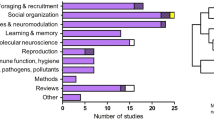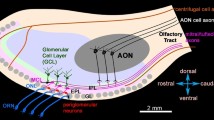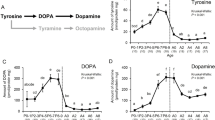Abstract
The biogenic amines serotonin (5HT) and octopamine (OA) exist in the bee and can modulate neuronal activity and behaviour. 5HT-like and OA-like immunoreactivities can be found in most neuropils of the brain. Binding sites for the two amines are also present in most brain neuropils. The highest density of binding sites for [3H]serotonin and [3H]octopamine was found in the mushroom bodies. In some brain areas, especially the mushroom bodies, mismatches exist between binding sites and immunoreactivities, suggesting that the two amines also bind to neuropils which are not directly innervated by 5HT-like or OA-like immunoreactive neurons. The action of the two amines on behaviour in the bee is antagonistic. In the antennal pathway, proboscis and antennal responses to olfactory and gustatory stimuli are enhanced by OA and reduced by 5HT. In olfactory conditioning experiments, storage and retrieval of the learned signal can be enhanced by OA and reduced by 5HT. The specificity of these effects depends on the site of amine application in the neuropil. In the visual system the direction specificity of the visual antennal response is enhanced by OA and reduced by 5HT after topical application or injection into the lobula, the third optic ganglion. Correlates for the behavioural modulation can be found in higher-order visual interneurons. While OA application can mimic the stimulation of the bee with sugar water, the behavioural conditions leading to the release of 5HT are not yet known.
Similar content being viewed by others
References
Agricola, H., Hertel, W., and Penzlin, H. Octopamin- Neurotransmitter, Neuromodulator, Neurohormon. Zool. Jb. Phsiol.92 (1988) 1–45.
Angioy, A. M., Tomassini Barbarossa, I., Crnjar, R., and Liscia, A., Effects of octopaminergic substances on the labellar lobe spreading response in the blowflyProtophormia terraenovae. Neurosci. Lett.103 (1989) 103–107.
Baines, R. A., Tyrer, N. M., and Downer, R. G. H., Serotonergic innervation of the locust mandibular closer muscle modulates contractions through the elevation of cyclic adenosine monophosphate. J. comp. Neurol.294 (1990) 623–632.
Bermudez, I., Beadle, D. J., and Benson, J. A., Multiple serotonin-activated currents in isolated, neuronal somata from locust thoracic ganglia. J. exp. Biol.165 (1992) 43–60.
Bicker, G., and Menzel, R., Chemical codes for the control of behaviour in arthropods. Nature337 (1989) 33–39.
Bicker, G., Schäfer, S., and Kingan, T. G., Mushroom body feedback interneurones in the honeybee show GABA-like immunoreactivity. Brain Res.360 (1985) 394–397.
Bicker, G., Schäfer, S., Ottersen, O. P., and Storm-Mathisen, J., Glutamate-like immunoreactivity in identified neuronal populations of insect nervous systems. J. Neurosci.8 (1988) 2108–2122.
Bicker, G., Taurine-like immunoreactivity in photoreceptor cells and mushroom bodies: a comparison of the chemical architecture of insect nervous systems. Brain Res.560 (1991) 201–206.
Branchek, T., More serotonin receptors? Curr. Biol.3 (1993) 315–317.93
Brüning, G., Kaulen, P., Scheidler, A., and Erber, J., [3H]Octopamine and [3H]serotonin binding sites in the brain of the honeybee (Apis mellifera carnica), Verh. anat. Ges.81 (1987) 859–860.
Carricaburu, P., and Munoz-Cuevas, A. La modulation du rythme visuel circadien par l'octopamine chez les scorpions et l'adaptation à la vie souterraine. C. R. Acad. Sci. Paris t.305 (1987) 285–288.
Casagrand, J. L., and Ritzmann, R. E., Biogenic amines modulate synaptic transmission between identified giant interneurons and thoracic interneurons in the escape system of the cockroach. J. Neurobiol.23 (1992) 644–655.
Claassen, D. E., and Kammer, A. E., Effects of octopamine, dopamine and serotonin on production of flight motor output by thoracic ganglia ofManduca sexta. J. Neurobiol.17 (1986) 1–14.
Davenport, A. P., and Evans, P. D., Changes in haemolymph octopamine levels associated with food deprivation in the locust,Schistocerca gregaria. Physiol. Ent.9 (1984) 269–274.
Davenport, A. P., and Evans, P. D., Stress-induced changes in the octopamine levels of insect haemolymph. Insect Biochem.14 (1984) 135–143.
David, J. C., Coulon, J. F., and Lafor-Cazal, M., Octopamine changes in nervous and nonnervous tissues of the locust,Locusta migratoria L., after different flight conditions. Comp. Biochem. Physiol.82C (1985) 427–432.
David, J.-C., and Coulon, J.-F., Octopamine in invertebrates and vertebrates. A review. Prog. Neurobiol.24 (1985) 141–185.
Eichmüller, S., Hammer, M., and Schäfer, S., Neurosecretory cells in the honeybee brain and suboesophageal ganglion show FMR Famide-like immunoreactivity. J. comp. Neurol.312 (1991) 164–174.
El Manira, A., Rossi-Durand, C., and Clarac, R., Serotonin and proctolin modulate the response of a stretch receptor in crayfish. Brain Res.541 (1991) 157–162.
Ellerkmann, E., Grandy, K., and Erber, J., Octopamine modulates the flexor and extensor muscles in the antenna of the honeybee, in: Gene-brain-behaviour, p. 179. Eds N. Elsner and M. Heisenberg. Thieme Verlag, Stuttgart-New York 1993.
Erber, J., Neural correlates of learning in the honeybee. TINS4 (1981) 270–273.
Erber, J., Response changes of single neurons during learning in the honeybee, in: Primary neural substrates of learning and behavioural change, pp. 275–285. Eds D. Alkon and R. Farley. Cambridge University Press, Cambridge, New York, 1984.
Erber, J. Kloppenburg, P., and Scheidler, A., Neuromodulation in the honeybee: autoradiography, behaviour and electrophysiology, in: The behaviour and physiology of bees, pp. 273–287. Eds L. J. Goodman and R. C., Fisher, CAB International, Wallingford 1991.
Erber, J., Masuhr, T., and Menzel, R., Localization of shortterm memory in the brain of the bee,Apis mellifera. Physiol. Ent.5 (1980) 343–358.
Erber, J., Pribbenow, B., Bauer, A., and Kloppenburg, P., Antennal reflexes in the honeybee: tools for studying the nervous system. Apidologie (1993) in press.
Erber, J., and Sandeman, D. C., The effect of serotonin and octopamine on the optikinetic response of the crabLeptograpsus variegatus. J. Neurobiol.20 (1989) 667–680.
Erber, J., and Schildberger, K. Conditioning of antennal reflex to visual stimuli in bees (Apis mellifera L.). J. comp. Physiol.135 (1980) 217–225.
Evans, P. D., Biogenic amines in the insect nervous system. Adv. Insect Physiol.15 (1980) 317–473.
Evans, P. D., Multiple receptor types for octopamine in the locust. J. Physiol.318 (1981) 99–122.
Evans, P. D., Properties of modulatory octopamine receptors in the locust, in: Ciba Foundation symposium 88, Neuropharmacology of insects, pp. 48–69. Pitman, London 1982.
Evans, P. D., Octopamine, in: Comprehensive insect phsiology biochemistry and pharmacology, vol. 11, Pharmacology, pp. 499–530. Eds G. A. Kerkut and L. I. Gilbert. Pergamon Press, Oxford-New York-Toronto-Sydney-Paris-Frankfurt 1985.
Evans, P. D., and Siegler, M. V. S., Octopamine mediated relaxation of maintained and catch tension in locust skeletal muscle. J. Physiol.324 (1982) 93–112.
Fischer, L., and Florey, E., Octopamine action on the contractile system of crustacean skeletal muscle. Comp. Biochem. Physiol.88C (1987) 335–342.
Florey, E., and Rathmayer, M., The effects of octopamine and other amines on the heart and on neuromuscular transmission in decapod crustaceans: further evidence for a role as neurohormone. Comp. Biochem. Physiol.61C (1978) 229–237.
Fuchs, E., Dustmann, J. H., Stadler, H., and Schürmann, F. W., Neuroactive compounds in the brain of the honeybee during imaginal life. Comp. Biochem. Physiol.92C (1989) 337–342.
Goldstein, R. S., and Camhi, J. M., Different effects of the biogenic amines dopamines, serotonin and octopamine on the thoracic and abdominal portions of the escape circuit in the cockroach. J. comp. Physiol.A168 (1991) 103–112.
Hammer, M., Menzel, R., and Schneider, U., Octopamine local injections into the mushroom body calyces substitute for the unconditioned stimulus in honeybee olfactory conditioning, in: Gene-brain-behaviour, p. 848. Eds N. Elsner and M. Heisenberg. Thieme Verlag, Stuttgart-New York 1993.
Harris, J. W., and Woodring, J., Effects of stress, age, season, and source colony on levels of octopamine, dopamine and serotonin in the honeybee (Apis mellifera L.) brain. J. Insect Physiol.38 (1992) 29–35.
Harris-Warrick, R. M., and Kravitz, E. A., Cellular mechanisms for modulation of posture by octopamine and serotonin in the lobster. J. Neurosci.4 (1984) 1976–1993.
Hertel, H., Schäfer, S., and Maronde, U., The physiology and morphology of visual commissures in the honeybee brain. J. exp. Biol.133 (1987) 283–300.
Hirashima, A., and Eto, M., Biogenic amines inPeriplaneta americana L.: Accumulation of octopamine, synephrine, and tyramine by stress. Biosci. Biotech. Biochem.57 (1993) 172–173.
Kinnamon, S. C., Klaassen, L. W., Kammer, A. E., and Claassen, D., Octopamine and chlordimeform enhance sensory responsiveness and production of the flight motor pattern in developing and adult moths. J. Neurobiol.15 (1984) 283–293.
Klaassen, L. W., and Kammer, A. E., Octopamine enhances neuromuscular transmission in developing and adult moths,Manduca sexta. J. Neurobiol.16 (1985) 227–243.
Kloppenburg, P., Homberg, U., Kühn, U., Binkle, U., and Erber, J., Gastrin/CCK in the mushroom bodies of the honeybee: immunocytochemistry and behaviour, in: Brain-perception cognition p. 322. Eds N. Elsner and G. Roth. Thieme Verlag, Stuttgart-New York 1990.
Kloppenburg, P., Neuroanatomische Charakterisierung der antennalen Motoneuronen und elektrophysiologische Untersuchungen zur aminergen Modulation des visuellen Antennenreflexes der Honigbiene. Dissertation Technische Universität Berlin, Fachbereich 14, 1990.
Kravitz, E. A., Beltz, B., Glusman, S., Goy, M., Harris-Warrick, R., Johnston, M. Livingstone, M., Schwarz, T., and King Siwicki, K. The well-modulated lobster. The roles of serotonin, octopamine, and proctolin in the lobster nervous system, in: Model neural networks and behavior, pp. 339–360. Ed. A. I. Selverston. Plenum Publishing Corporation, New York 1985.
Kreissl, S., and Bicker, G., Histochemistry of acetylcholinesterase and immunocytochemistry of an acetylcholine receptor-like antigen in the brain of the honeybee. J. comp. Neurol.286 (1989) 71–84.
Kreissl, S., Eichmüller, S., Bicker, G., Rapus, J., and Eckert, M., The distribution of octopamine-like immunoreactivity in the brain of the honeybee, in: synapse-transmission modulation, p. 407. Eds N. Elsner and H. Penzlin. Thime Verlag, Stuttgart-New York 1991.
Linn, C. E., and Roelofs, W. L., Modulatory effects of octopamine and serotonin on male sensitivity and periodicity of response to sex pheromone in the cabbage looper moth,Trichoplusia ni. Arch Insect Biochem. Physiol.3 (1986) 161–171.
Livingstone, M. S., Harris-Warrick, R. M., and Kravitz, E. A., Serotonin and octopamine produce opposite postures in lobsters. Science208 (1980) 76–79.
Maronde, U., Common projection areas of antennal and visual pathways in the honeybee brain,Apis mellifera. J. comp. Neurol.309 (1991) 328–340.
Maronde, U., Projections of antennal sensilla and common projection areas with visual interneurons in the brain of the bee, in: Brain-perception cognition, p. 46. Eds N. Elsner and G. Roth. Thieme Verlag, Stuttgart-New York 1990.
Masson, C., Central olfactory pathways and plasticity of responses to odorous stimuli in insects, in: Olfaction and taste vol. 6, pp. 305–314. Eds J. Le Magner and P. Mac Leod. IRL, London 1977.
Menzel, R., Neurobiology of learning and memory: the honeybee as a model system. Naturwissenschaften70 (1983) 504–511.
Menzel, R., Durst, C., Erber, J., Eichmüller, S., Hammer, M., Hildebrandt, H., Manuelshagen, J. Müller, U., Rosenboom, H., Rybak, J., Schäfer, S., and Scheidler, A., The mushroom bodies in the honeybee: from molecules to behavior, in: Fortschritte der Zoologie vol. 39, Neuronal basis of behavioural adaptations. Eds K. Schildberger and N. Elsner, Fischer Verlag, Stuttgart 1993 in press.
Menzel, R., Hammer, M., Braun, G., Manuelshagen, J., and Sugawa, M., Neurobiology of learning and memory in honeybees, in: The behaviour and physiology of bees, pp. 323–353. Eds L. J. Goodman and R. C. Fisher. CAB International, Wallingford 1991.
Menzel, R., Michelsen, B., Rüffer, P., and Sugawa, M., Neuropharmacology of learning and memory in honey bees, in: NATO ASI series, vol. H19, Modulation of synaptic transmission and plasticity in nervous systems, pp. 332–350. Eds G. Hertting and H.-C. Spatz. Springer Verlag, Berlin-Heidelberg 1988.
Menzel, R., Wittstock, S., and Sugawa, M., Chemical codes of learning and memory in honey bees, in: The biology of memory, pp. 335–358. Eds L. R. Squire and E. Lindenlaub. Schattauer Verlag, Stuttgart-New York 1990.
Mercer, A. R., and Erber, J., The effects of amines on evoked potentials recorded in the mushroom bodies of the bee brain. J. comp. Physiol.A151 (1983) 469–476.
Mercer, A. R., and Menzel, R., The effects of biogenic amines on conditioned and unconditioned responses to olfactory stimuli in the honeybeeApis mellifera. J. comp. Physiol.A145 (1982) 363–368.
Mercer, A. R., Mobbs, P. G., Davenport, A. P., and Evans, P. D., Biogenic amines in the brain of the honeybee,Apis mellifera. Cell Tissue Res.234 (1983) 655–677.
Michelsen, B., Catecholamines affect storage and retrieval of conditioned odour stimuli in honey bees. Comp. Biochem. Physiol.91C (1988) 479–482.
Mobbs, P. G., The brain of the honeybeeApis mellifera. I. The connections and spatial organization of the mushroom bodies. Phil. Trans. R. Soc.298 (1982) 309–354.
Mulloney, B., Acevedo, L. D., and Bradbury, A. G., Modulation of the crayfish swimmeret rhythm by octopamine and the neuropeptide proctolin. J. Neurophysiol.58 (1987) 584–597.
Noble, M., and Goodman, L., Immunohistochemical localisation of a Gastrin/CCK like peptide in the brain of the honeybee, in: Chemistry and biology of social insects, pp. 202–203. Eds J. Eder and H. Rembold, Pepperny, München 1987.
O'Day, P. M., and Lisman, J. E., Octopamine enhances dark-adaptation in Limulus ventral photoreceptors. J. Neurosci.5 (1985) 1490–1496.
O'Gara, B. A., and Drewes, C. D., Modulation of tension production by octopamine in the metathoracic dorsal longitudinal muscle of the cricketTeleogryllus oceanicus. J. exp. Biol.149 (1990) 161–176.
Orchard, I., Ramirez, J. M., and Lange, A. B. A multifunctional role for octopamine in locust flight. A. Rev. Ent.38 (1993) 227–249.
O'Shea, M., and Evans, P. D., Potentiation of neuromuscular transmission by an octopaminergic neurone in the locust. J. exp. Biol.79 (1979) 169–190.
Pareto, A., Die zentrale Verteilung der Fühlerafferenz bei Arbeiterinnen der Honigbiene,Apis mellifera L. Z. Zellforsch.131 (1972) 109–140.
Parsons, D. W., and Pinsker, H. M., Swimming in Aplysia brasiliana: behavioral and cellular effects of serotonin. J. Neurophysiol.62 (1989) 1163–1176.
Pasztor, V. M. and Bush, B. M. H., Primary afferent responses of a crustacean mechanoreceptor are modulated by proctolin, octopamine and serotonin. J. Neurobiol.20 (1989) 234–254.
Pasztor, V. M., Modulation of sensitivity in invertebrate sensory receptors, in: Seminars in the neurosciences, vol. 1, pp. 5–14. Ed. E. Marder. Saunders Scientific Publications, Philadelphia 1989.
Ramirez, J.-M., and Orchard, I., Octopaminergic modulation of the forewing stretch receptor in the locustLocusta migratoria. J. exp. Biol.149 (1990) 255–279.
Ramirez, J.-M., Pearson, K. G., Octopaminergic modulation of interneurons in the flight system of the locust. J. Neurophysiol.66 (1991) 1522–1537.
Redouane, K., and Fuzeau-Braesch, S., L'octopamine: répartition et role dans le système nerveux des Invertébrés et des Vertébrés. Agressologie25 (1984) 3–12.
Rehder, V., Bicker, G., and Hammer, M., Serotonin-immunoreactive neurons in the antennal lobes and suboesophageal ganglion of the honeybee. Cell Tissue Res.247 (1987) 59–66.
Riens, H., Grandy, K., and Erber, J., The behavioral effects of serotonin and putative ligands in the honey bee: comparison between two different injection sites in the brain, in: Rhythmogenesis in neurons and networks, p. 525. Eds N. Elsner and D. W. Richter. Thieme Verlag, Stuttgart-New York 1992.
Roeder, T., and Gewecke, M., Octopamine receptors in locust nervous tissue. Biochem. Pharmac.39 (1990) 1793–1797.
Roeder, T., High-affinity antagonists of the locust neuronal octopamine receptor. Eur. J. Pharmac.191 (1990) 221–224.
Roeder, T., and Nathanson, J. A., Characterization of insect neuronal octopamine receptors (OA3 receptors). Neurochem. Res.18 (1993) 921–925.
Schäfer, S., and Bicker, G., Common projection areas of 5-HT-and GABA-like immunoreactive fibers in the visual system of the honeybee. Brain Res.380 (1986) 368–370.
Schäfer, S., Bicker, G., Ottersen, O. P., and Storm-Mathisen, J., Taurine-like immunoreactivity in the brain of the honeybee. J. comp. Neurol.268 (1988) 60–70.
Schäfer, S., Rehder, V., Dopamine-like immunoreactivity in the brain and suboesophageal ganglion of the honeybee. J. comp. Neurol.280 (1989) 43–58.
Schäfer, S., Rosenboom, H., and Menzel, R., Ionic currents of identified neurons from the mushroom bodies of the honeybee,Apis mellifera, in: Gene-brain-behaviour p. 635. Eds N. Elsner and M. Heisenberg. Thieme Verlag, Stuttgart-New York 1993.
Scheidler, A., Autoradiographische Darstellung von Bindungsstellen für verschiedene Neurotransmitter-Kandidaten im Gehirn der Hongbiene (Apis mellifera L.) Dissertation Technische Universität Berlin, Fachbereich 14, 1991.
Scheidler, A., Kaulen, P., and Brüning, G., Quantitative autoradiographic localization of (125I) alpha-bungarotoxin binding sites in the honeybee brain. Brain Res.534 (1990) 332–335.
Schürmann, F. W., Elekes, K., and Geffard, M., Dopamine-like immunoreactivity in the bee brain. Cell Tissue Res.256 (1989) 399–410.
Schürmann, F. W., and Erber, J., FMR Famide-like immunoreactivity in the brain of the honeybee (Apis mellifera). A light- and electron micron microscopical study. Neuroscience38 (1990) 797–807.
Schürmann, F. W., and Klemm, N., Serotonin-immunoreactive neurons in the brain of the honeybee. J. comp. Neurol.225 (1984) 570–580.
Sombati, S., and Hoyle, G., Central nervous sensitization and dishabituation of reflex action in an insect by the neuromodulator octopamine. J. Neurobiol.15 (1984) 455–480.
Sombati, S., and Hoyle, G., Generation of specific behaviors in a locust by local release into neuropil of the natural neuromodulator octopamine. J. Neurobiol.15 (1984) 481–506.
Stevenson, P. A., and Kutsch, W., A reconsideration of the central pattern generator concept for locust flight. J. comp. Physiol.A161 (1987) 115–129.
Stieve, H., and André, E., Octopamine modulates the sensitivity ofLimulus ventral photoreceptor. Z. Naturforsch.39C (1984) 981–985.
Strausfeld, N. J., Atlas of an insect brain. Springer Verlag, Berlin-Heidelberg-New York 1976.
Suter, C. The action of octopamine and other biogenic amines on locust central neurons. Comp. Biochem. Physiol.84C (1986) 181–187.
Suzuki, H., Antennal movements induced by odour and central projection of the antennal neurones in the honey-bee. J. Insect Physiol.21 (1975) 831–847.
Taylor, D. J., Robinson, G. E., Logan, B. J., Laverty, R., and Mercer, A. R., Changes in brain amine levels associated with the morphological and behavioural development of the worker honeybee. J. comp. Physiol.A170 (1992) 715–721.
Washio, H., and Tanaka, Y., Some effects of octopamine, proctolin and serotonin on dorsal unpaired median neurones of cockroach (Periplaneta americana) thoracic ganglia, J. Insect Physiol.38 (1992) 551–517.
Wedemeyer, S., Roeder, T., and Gewecke, M., Pharmacological characterization of a 5-HT receptor in locust nervous tissue. Eur. J. Pharmac.223 (1992) 173–178.
Whim, M. D., and Evans, P. D., Octopaminergic modulation of flight muscle in the locust. J. exp. Biol.134 (1988) 247–266.
Woodring, J. P., Williams Meier, O., and Rose, R., Effect of development, photoperiod, and stress on octopamine levels in the house cricket,Acheta domesticus. J. Insect Physiol.34 (1988) 759–765.
Yamamoto, D., and Ishikawa, S., Neuromodulator octopamine attenuates extrajunctional glutamate sensitivity in insect muscle. Archs. Insect Biochem. Physiol.18 (1991) 265–272.
Zhang, B. G., Torkeli, P. H., and French, A. S., Octopamine selectively modifies the slow component of sensory adaptation in an insect mechanoreceptor. Brain Res.591 (1992) 351–355.
Author information
Authors and Affiliations
Rights and permissions
About this article
Cite this article
Erber, J., Kloppenburg, P. & Scheidler, A. Neuromodulation by serotonin and octopamine in the honeybee: behaviour, neuroanatomy and electrophysiology. Experientia 49, 1073–1083 (1993). https://doi.org/10.1007/BF01929916
Received:
Accepted:
Issue Date:
DOI: https://doi.org/10.1007/BF01929916




